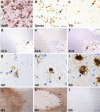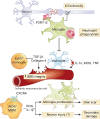Microglia and monocytes in inflammatory CNS disease: integrating phenotype and function
- PMID: 34853891
- PMCID: PMC8742818
- DOI: 10.1007/s00401-021-02384-2
Microglia and monocytes in inflammatory CNS disease: integrating phenotype and function
Abstract
In neurological diseases, the actions of microglia, the resident myeloid cells of the CNS parenchyma, may diverge from, or intersect with, those of recruited monocytes to drive immune-mediated pathology. However, defining the precise roles of each cell type has historically been impeded by the lack of discriminating markers and experimental systems capable of accurately identifying them. Our ability to distinguish microglia from monocytes in neuroinflammation has advanced with single-cell technologies, new markers and drugs that identify and deplete them, respectively. Nevertheless, the focus of individual studies on particular cell types, diseases or experimental approaches has limited our ability to connect phenotype and function more widely and across diverse CNS pathologies. Here, we critically review, tabulate and integrate the disease-specific functions and immune profiles of microglia and monocytes to provide a comprehensive atlas of myeloid responses in viral encephalitis, demyelination, neurodegeneration and ischemic injury. In emphasizing the differential roles of microglia and monocytes in the severe neuroinflammatory disease of viral encephalitis, we connect inflammatory pathways common to equally incapacitating diseases with less severe inflammation. We examine these findings in the context of human studies and highlight the benefits and inherent limitations of animal models that may impede or facilitate clinical translation. This enables us to highlight common and contrasting, non-redundant and often opposing roles of microglia and monocytes in disease that could be targeted therapeutically.
Keywords: Encephalitis; Immune-mediated pathology; Microglia; Monocyte-derived cells; Neurodegeneration; Neuroinflammation.
© 2021. The Author(s).
Conflict of interest statement
The authors have no conflicts of interest to declare that are relevant to the content of this article.
Figures





References
-
- Ajami B, Bennett JL, Krieger C, Tetzlaff W, Rossi FM. Local self-renewal can sustain CNS microglia maintenance and function throughout adult life. Nat Neurosci. 2007;10:1538–1543. - PubMed

